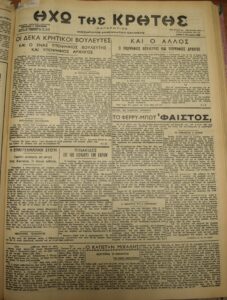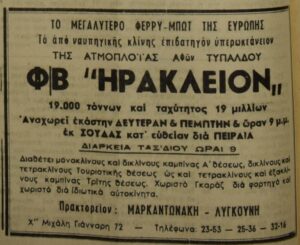The ships that became bridges off the island
City
Migration Period
City Narratives
Tag
Category
Full Description
Postwar reality in Crete evolved in a way that encouraged population movement, leading to an increase in migration. Tentatively during the 1950s and more intensely in the 1960s, Cretans resorted to migrating abroad, some across the ocean to the USA or Australia, but most to central Europe, mainly the Federal Republic of Germany. In addition, a large part of the island’s population moved to Athens in search of better living conditions closer to home.
This migration wave caused the Crete-Piraeus route to become increasingly busy as each internal migrant who resettled in Athens would have to travel back and forth from the island several times, while their family would also visit Athens often. As a result, with each resettlement, the number of travellers between Crete and Athens increased significantly.
Besides, the rise in living standards which characterised the postwar world slowly but systematically also affected Greece, raising hopes and expectations which could not be met on the island until at least the 1980s. For example, the health facilities available in Crete could not meet the healthcare needs of the entire population. The first major hospital established on the island postwar was Venizeleio Hospital in Heraklion, created as ‘Pan-Cretan Hospital for Tubercular Patients’ in 1953 and funded by the Greek community in the USA. It wasn’t until 1967 that it was converted into a general hospital offering all basic medical services with a capacity of 200 beds. Consequently, travelling to the capital for health reasons was common among Cretans.
Moreover, the older generations hoped their children would have a chance to build a life that did not rely on farmwork and thus encouraged them to further their studies. Until at least the end of the 1970s, Athens and Thessaloniki were the two cities that received large numbers of Cretan students due to the absence of provincial universities. To cover the housing needs of these students, the Cretan Student Residence, an accommodation facility for Cretan students located in downtown Athens, was established in 1970. The University of Crete opened its doors in 1977. For the young people who failed to enter a Greek university or did not wish to sit the entrance exams, there was also the option of studying abroad. Especially during the 1970s, many Cretans opted to study at Italian universities and until recently, many of the engineers and doctors who worked on the island had studied in Italy. In a local newspaper from 1966, we find an advertisement placed by Typaldos Lines, also known as the Aegean Steam Navigation Company, which advertised the connection from Crete to Italy and central Europe with the ‘ferry boat Hania, the largest ocean liner ferry boat in the world.’
Finally, the emergence of a strong immigrant identity in foreign environments, both in Athens and abroad, led many of the migrants to search for brides in their place of origin. That was how they maintained (or established) a Cretan identity which carried distinct characteristics that allowed them to belong to a community, for example the Cretans of Athens, Munich, Melbourne, and so on. In turn, the brides who resettled in Athens further increased the number of trips between Crete and the capital made by both themselves and their families.
In this way, the ships that linked the island with other destinations transformed into communication bridges which were becoming increasingly necessary. The local press and the travelling Cretans soon became preoccupied with the state of the ships, the safety of the journey, the conditions on board and other relevant issues. More and more advertisements for ship lines serving the Crete-Piraeus route were being published in the local press. From time to time, comments on the journeys and critiques of the travelling conditions on these ships made their appearance in the pages of the local newspapers.
In addition, some particularly memorable stories from the journey or the arrival at Piraeus have been passed down from generation to generation through the years; stories of fearful people travelling for the first time to the capital, trying desperately to find a compatriot among hundreds of strangers; of parents loading the ships with cheese, sacks of vegetables and live chickens to be slaughtered on some Athenian balcony; of patients carrying cans of olive oil to the capital’s hospitals as a present to the surgeon that would be operating on them.
Ch. Bournazos described his first journey to Athens: ‘Did I have a seat? Of course, business class! On the deck of a shipwreck waiting to happen, travelling with monks, priests, farmers, fishermen and chickens. One actually laid an egg and cackled to announce it just as I was finally falling asleep. There was an abundance of poultry, hens and cocks, brought by the passengers or sent via ship as gifts to their friends, compatriots, relatives and state officials. One of them, Dimitris Markantonis, actually received about twenty-five cocks. What was the man supposed to do? Eat chicken every single day? He would end up cackling himself! So he turned the open space of the apartment block into a coop and kept them there.’ (Eleftheropolis, 2011)
Ch. Spyridaki recalls funny anecdotes circulating in her family involving compatriots travelling to the capital for the first time, but also has her own memories of travelling on the Crete-Piraeus ships as a kid in the 1970s: ‘I remember people lying on the bed, opening their little plastic containers to eat as the ship was leaving the port and smelling all sorts of smells. From cabbage rolls to… I don’t know… bean soup. As they all opened their bowls, the corridor became saturated with all sorts of food smells. I remember it as being a really foul smell.’
These people, whether they moved permanently or temporarily, took more than local or homemade products on the ship; they took home itself. They were trying to imbue the journey with a sense of familiarity, to turn the ship’s public spaces into a recognisable cocoon, to transport the atmosphere of their homes to the capital or to their loved ones. This effort on behalf of the travellers was undermined to a large extent by the sinking of the SS Heraklion in the winter of 1966. The shipwreck reminded them that no matter how much they might want to treat the ships as extensions of their homeland, they did not control them and could not guarantee their safety.
This could explain the demand for a ship line owned exclusively by Cretans that was raised immediately after the shipwreck. It was as if the residents of the island were trying to ensure their safety by appealing to the camaraderie among compatriots. This was not just a demand to establish a ship line that would prioritise ship safety and good journey conditions over profit. It was a belief that if the ship owners were fellow Cretans, they would afford the travellers respect and protection because they shared the same needs and desires.
A few days after the shipwreck, a local newspaper wrote: ‘We must all take an active interest in what is to happen from now on. First, so that we never have to mourn such a tragedy ever again. Second, so that these few, unconscionable people stop taking advantage of our needs that make us get on their ships: sickness, joy, grief. Commerce, for those engaged in it, and any other need emerging from our everyday struggles for ourselves and our loved ones.’ One of the pieces promoting the creation of a Cretan shipping consortium reads: ‘CRETE SHIPPING LINE S.A. CRETAN HOUSEHOLD’.
Bibliography
Pantelis Kyprianos, ‘Knowledge, social distinction, job security: the Greek students abroad from 1837 until today’, Sygchroni Ekpaidefsi, no. 156 (January-March 2009), pp. 28-48.
Konstantina Spantidaki, The formation of Cretan identity in modern Greece, graduate thesis, Department of Geography, Harokopio University of Athens, Athens 2012.
Charalambos Bournazos, ‘The old man’s short letter. My first journey to Athens’, Eleftheropolis, no.61 (April, May, June 2011)
https://www.venizeleio.gr/to-nosokomio/istoria/
https://www.lib.uoc.gr/info/absrv/rare/barch/extra-1182764125-530232-32216.tkl










